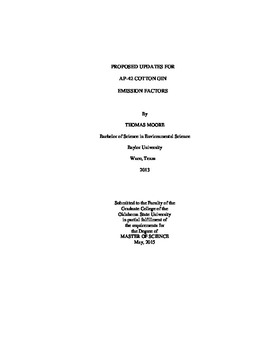| dc.description.abstract | A cotton ginning industry-supported project (National Study) was initiated in 2008 and completed in 2013 to collect additional particulate matter (PM) data for EPA's AP-42. PM stack emissions were collected using three EPA-approved methodologies and particle size analysis for 17 cotton gin systems. This study used the National Study and the 1996 AP-42 PM data and EPA's 2013 Emission Factor Development Procedures to develop suggested PM2.5, PM10, and total PM cotton gin emission factors, particle size distribution (PSD) characteristics, and evaluate EPA's development methodology. Unrepresentative test runs were removed from the National Study dataset for erratic gin operation, laboratory errors, or if the data was an outlier. Test runs were assign Individual Test Ratings (ITRs), ordered by descending "test" ITR for a given system, which was used to calculate Factor Quality Indices (FQI). If a "test" ITR increased the FQI, that "test" and those below it were excluded from the system emission factor calculation. Three "Test" Designs were evaluated to determine which was best for calculating emission factors and associated ratings. Test data ratings from the 1996 AP-42 were converted to ITRs and rerated with the ITR methodology to determine how that data should be handled. PSD data was evaluated for inclusion with EPA-approved emissions data. The optimal "Test" Design was determined to be one that used the average of all test runs from a single sampling method on a single system at a single facility as a "test." It was determined that the 1996 AP-42 data ratings should be rerated. PSD data should be combined with the section 9.7 emission factors. Final suggested typical gin emission factors were 0.0459 (0.1013), 0.4514 (0.9951), and 0.9404 kg/bale (2.0732 lb/bale) for PM2.5, PM10, and total PM, respectively. Final suggested typical gin PM10 and total PM emission factors were 22% higher and 14% lower than the 1996 AP-42 emission factors, respectively. Final suggested typical gin PM2.5, PM10, and total PM emission factors were 33, 22, and 0.81% lower than the National Study technical reports. Twelve, 53, and 71% of the final suggested PM2.5, PM10, and total PM emission factors rated "highly representative," respectively. | |
